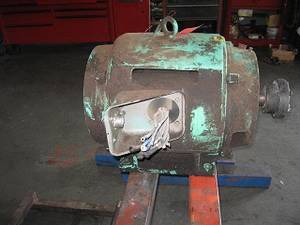ODP vs TEFC Motors
What's the Difference Between a ODP and TEFC Motor?
The ODP vs TEFC debate has been extensively covered by others, but our repair shops find evidence of poor performing ODP applications on a monthly basis. Open drip proof motors are just that - open. It's like an open door from whatever is outside, to your bearings and windings on the inside. At one time they were very common and known for cooling characteristics. A lot has changed since those days.
An often overlooked step to improve motor reliability is simply to upgrade open drip proof (ODP) motors. The lower initial cost of simply repairing or replacing these can be appealing, but the shorter run life tends to increase your cost and reduce liability. Whether specified on equipment or installed on a change out ODP motors can be a high risk point. Some concerns with their design are:
- The ventilating openings permit passage of external cooling air over and around the windings of the motor.
- There is a very small degree of protection against liquid or solid particles entering the enclosure.
- Most ODP designs offer class B insulation which yields less protection versus heat.
- Bearing failures, as a result of extensive contamination, are often so catastrophic that they destroy the windings as well.
ODP vs TEFC - Its about a better motor enclosure
Most repeat, premature ODP failures are associated with bearing contamination. There is not enough protection at the shaft passage, not to mention the open vents allowing virtually any contaminant a welcome entry. ODP failures usually look like this:
 | 1. A failed ODPThis ODP motor is caked with contamination (solids). Note the air entry and imagine how much more is inside. It sustained several failures, and based on the date of the previous repair - all were premature. This motor will continue to fail, driving up expenses, until an improvement is made. How much more is on the inside? |
 | 2. ODP BearingSimply repairing this motor an putting it back into an environment it was not designed for will cause it to fail again. This bearing does not stand a chance. A TEFC design would do a far better job to keep this contamination out. What else is in the grease? |
 | 3. RotorThe added contamination inside an ODP motor can destroy the bearings and the windings. Layers of contamination act as insulation of heat and impede air flow. Though ODP motors are known for running cooler by design, such layering can create isolated hot spots. This does not belong here! |
 | 4. WindingWe usually see the bearing disintegrate and its shrapnel destroy the winding. In this case, pure abrasion over time did it. The constant presence of contamination, together with the mechanical motion of the rotor, acted as an abrasive on this winding. Note the excessive wear pattern on the lamination. Contamination Wear |
These failures are what typically drive the ODP vs TEFC conversation. The logical step is to replace the ODP with a standard, off the shelf TEFC motor (though some modification may be required). A TEFC (totally enclosed fan cooled) motor is a far better choice, as it “totally encloses” the interior, with some exceptions. For a good comparison of these enclosure types, check out this link on the electrical engineering portal.
ODP versus TEFC
A few items to consider when converting:
- What is the overall length of the motor that is being replaced and is there room for a longer motor to be installed? Often times a TEFC will have a longer design and this should be taken into consideration. A request for specification sheets will clarify any questions if space is a concern.
- If the motor is a replacement, why did the last one fail? If there is evidence of excessive dirt or contaminants on the windings this could be a good candidate for conversion.
- Where is the motor going to be located (environment/temp)?
- What airborne contaminants (including water) will it be exposed to?
- How is the motor powered (starter, VFD, Soft Start, etc…)?
- What is the load, how is it coupled, and what is the speed range?
Some general suggestions for selecting the right motor
If you want to ensure the motor decision you’re making will yield the longest run life consider the following:
- A totally enclosed fan cooled (TEFC) should be the standard starting point. Replace ODP motors, and upgrade to TEFC.
- All motors placed outdoors should be TEFC severe duty rated or higher.
- Motors exposed to airborne contaminants (dirt, ash, paper, etc.), frequent temperature variation, and the greater stress of the process industry should be replaced with TEFC severe duty as a minimum.
- When TEFC severe duty does not hold up, as often is the case in the paper, metals, and chemical industries, it usually makes sense to upgrade to IEEE 841.
Whether it’s an installed base evaluation, or simple a consult for a single application, we are glad to help.










